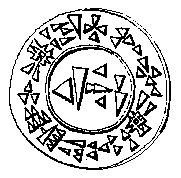Ašmu-nikal
| Ašmu-Nikkal | |
|---|---|
| Queen of Hittite empire | |
 | |
| Spouse | Arnuwanda I |
| Issue | Tudḫaliya III Ašmi-Šarruma Mannini Pariyawatra Kantuzzili Tulpi-Teššub |
| Father | Tudḫaliya II |
| Mother | Nikkal-mati |

Ašmu-nikal or Ašmu-Nikkal was a Queen consort of the Hittite empire.
Biography[edit]
Ašmu-Nikkal was born as a princess, the daughter of the Hittite great king Tudḫaliya II (also called Tudḫaliya I/II) and Queen Nikkal-mati.[1] She married a man called Arnuwanda, who became Tudḫaliya II's heir, co-ruler, and eventual successor.[2] The nature of the relationship between Ašmu-Nikkal and her husband Arnuwanda was long controversial, since both are described as children of Tudḫaliya II on their respective seals,[3] ostensibly implying that they were siblings or at least half-siblings.[4] This, however, was clearly forbidden by Hittite custom and law,[5] and it is now generally agreed that while Ašmu-Nikkal was indeed the daughter of Tudḫaliya II, Arnuwanda was only his son-in-law and possibly adoptive son, as the daughter's antiyant husband, an acceptable heir in the absence of a son.[6]
Ašmu-Nikkal and Arnuwanda I appear to have had several sons: Ašmi-Šarruma, Mannini, Pariyawatra, Kantuzzili, Tulpi-Teššub, and the future king Tudḫaliya III.[7] Through her son Tudḫaliya III, she was the grandmother of Tudhaliya the Younger and of Ḫenti, the wife of Šuppiluliuma I.[8]
Ašmu-Nikkal, great queen of Hatti, seems to have actively participated in the government of her husband Arnuwanda I, and is cited with him in administrative documents and oaths.[9] Together with Arnuwanda, she offered up prayers to the gods to alleviate the Kaška invasion of the northern portions of the Hittite kingdom.[10] Some instructions and decrees, for example those regarding the rights and entitlements of the "mausoleum guardians," were issued in the queen's name alone.[11] It is possible that Ašmu-Nikkal survived her husband.[12]
Gallery[edit]
-
Prayers of Arnuwanda and Asmu-Nikkal, 14th century BC, from Hattusa, Istanbul Archaeological Museum
-
Gifts given by Arnuwanda and Asmu-Nikkal, 14th century BC, from Hattusa, Istanbul Archaeological Museum
| ||||||||||||||||||||||||||||||||||||||||||||||||||||||||||||||||||||||||||||||||||||||||||||||||||||||||||||||||||||||||||||||||||||||||||||||||||||||||||||||||||||||||||||||||||||||||||||||||||||||||||||||||||||||||||||||||||||||||||||||||||||||||||||||||||||||||||||||||||||||||||||||||||||||||||||||||||||||||||||||||||||||||||||||||||||||||||||||||||||||||||||||||||||||||||||||||||||||||||||||||||||||||||||||||||||||||||||||||||||||||||||||||||||||||||||||||||||||||||||||||||||||||||||||||||||||||||||||||||||||||||||||||||||||||||||||||||||||||||||||||||||||||||||||||||||||||||||||||||||||||||||||||||||||||||||||||||||||||||||||||||||||||||||||||||||||||||||||||||||||||||||||||||||||||||||||||||||||||||||||||||||||||||||||||||||||||||||||||||||||||||||||||||||||||||||||||||||||||||||||||||||||||||||||||||||||||||||||||||||||||||||||||||||||||||||||||||||||||||||||||||||||||||||||||||||||||||||||||||||||||||||||||||||||||||||||||||||||||||||||||||||||
| ||||||||||||||||||||||||||||||||||||||||||||||||||||||||||||||||||||||||||||||||||||||||||||||||||||||||||||||||||||||||||||||||||||||||||||||||||||||||||||||||||||||||||||||||||||||||||||||||||||||||||||||||||||||||||||||||||||||||||||||||||||||||||||||||||||||||||||||||||||||||||||||||||||||||||||||||||||||||||||||||||||||||||||||||||||||||||||||||||||||||||||||||||||||||||||||||||||||||||||||||||||||||||||||||||||||||||||||||||||||||||||||||||||||||||||||||||||||||||||||||||||||||||||||||||||||||||||||||||||||||||||||||||||||||||||||||||||||||||||||||||||||||||||||||||||||||||||||||||||||||||||||||||||||||||||||||||||||||||||||||||||||||||||||||||||||||||||||||||||||||||||||||||||||||||||||||||||||||||||||||||||||||||||||||||||||||||||||||||||||||||||||||||||||||||||||||||||||||||||||||||||||||||||||||||||||||||||||||||||||||||||||||||||||||||||||||||||||||||||||||||||||||||||||||||||||||||||||||||||||||||||||||||||||||||||||||||||||||||||||||||||||
References:
| ||||||||||||||||||||||||||||||||||||||||||||||||||||||||||||||||||||||||||||||||||||||||||||||||||||||||||||||||||||||||||||||||||||||||||||||||||||||||||||||||||||||||||||||||||||||||||||||||||||||||||||||||||||||||||||||||||||||||||||||||||||||||||||||||||||||||||||||||||||||||||||||||||||||||||||||||||||||||||||||||||||||||||||||||||||||||||||||||||||||||||||||||||||||||||||||||||||||||||||||||||||||||||||||||||||||||||||||||||||||||||||||||||||||||||||||||||||||||||||||||||||||||||||||||||||||||||||||||||||||||||||||||||||||||||||||||||||||||||||||||||||||||||||||||||||||||||||||||||||||||||||||||||||||||||||||||||||||||||||||||||||||||||||||||||||||||||||||||||||||||||||||||||||||||||||||||||||||||||||||||||||||||||||||||||||||||||||||||||||||||||||||||||||||||||||||||||||||||||||||||||||||||||||||||||||||||||||||||||||||||||||||||||||||||||||||||||||||||||||||||||||||||||||||||||||||||||||||||||||||||||||||||||||||||||||||||||||||||||||||||||||||
Notes:
| ||||||||||||||||||||||||||||||||||||||||||||||||||||||||||||||||||||||||||||||||||||||||||||||||||||||||||||||||||||||||||||||||||||||||||||||||||||||||||||||||||||||||||||||||||||||||||||||||||||||||||||||||||||||||||||||||||||||||||||||||||||||||||||||||||||||||||||||||||||||||||||||||||||||||||||||||||||||||||||||||||||||||||||||||||||||||||||||||||||||||||||||||||||||||||||||||||||||||||||||||||||||||||||||||||||||||||||||||||||||||||||||||||||||||||||||||||||||||||||||||||||||||||||||||||||||||||||||||||||||||||||||||||||||||||||||||||||||||||||||||||||||||||||||||||||||||||||||||||||||||||||||||||||||||||||||||||||||||||||||||||||||||||||||||||||||||||||||||||||||||||||||||||||||||||||||||||||||||||||||||||||||||||||||||||||||||||||||||||||||||||||||||||||||||||||||||||||||||||||||||||||||||||||||||||||||||||||||||||||||||||||||||||||||||||||||||||||||||||||||||||||||||||||||||||||||||||||||||||||||||||||||||||||||||||||||||||||||||||||||||||||||
References[edit]
- ^ Klengel 1999: 121, n. 165; Bryce 2005: 128-129; Freu 2007b: 98, 102, 117-118; Weeden 2022: 569.
- ^ Bryce 2005: 128; Freu 2007b: 98, 102-103, 117; Weeden 2022: 569.
- ^ Beal 1983: 116.
- ^ Astour 1989: 68.
- ^ Beal 1982: 116-117.
- ^ Beal 1983: 117-119; Bryce 2005: 128; Freu 2007b: 98, 102-103, 117; Weeden 2022: 569.
- ^ Bryce 2005: 145; Freu 2007b: 148-151; De Martino 2010: 132.
- ^ Freu 2007b: 198-201; Stavi 2011: 228-230; Taracha 2016: 492-493.
- ^ Freu 2007b: 137, 145.
- ^ Bryce 2005: 142; Freu 2007b: 138-141 and (Mazoyer) 325-329 with French translation.
- ^ Freu 2007b: 118.
- ^ Freu 2007b: 118.
Bibliography[edit]
- Astour, Michael C. (1989), Hittite History and the Absolute Chronology of the Bronze Age, Partille.
- Beal, Richard R. (1983), "Studies in Hittite History," Journal of Cuneiform Studies 35 (1983) 115-126.
- Bryce, Trevor (2005), The Kingdom of the Hittites, Oxford.
- De Martino, Stefano (2010), "Nomi di persona hurriti nella prima età imperiale ittita," Orientalia 79 (2010) 130-139.
- Freu, Jacques, and Michel Mazoyer (2007b), Les débuts du nouvel empire hittite, Paris.
- Klengel, Horst (1999), Geschichte des Hethitischen Reiches, Leiden.
- Stavi, Boaz (2011), "The Genealogy of Suppiluliuma I," Altorientalische Forschungen 38 (2011) 226–239. online
- Taracha, Piotr (2016), "Tudhaliya III's Queens, Šuppiluliuma's Accession and Related Issues," in Sedat Erkut and Özlem Sir Gavaz (eds.), Studies in Honour of Ahmet Ünal Armağanı, Istanbul: 489-498.
- Weeden, Mark (2022), "The Hittite Empire," in Karen Radner et al. (eds.), The Oxford History of the Ancient Near East, vol. 3 (From the * Hyksos to the Late Second Millennium BC), Oxford: 529-622.


